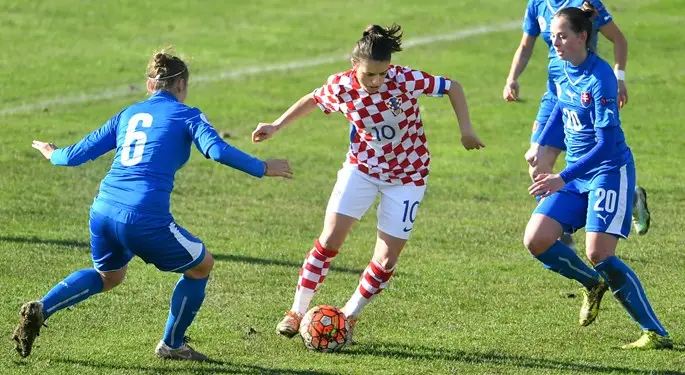Women’s football has had many ups and downs throughout history. From being dismissed as only a man’s sport to its “golden age,” the ban that stopped the sport’s progress and, in the end, one of the most significant rises in popularity of any sport in history. The “golden age” occurred in England at the beginning of the 20th century when British men were deployed and sent to the frontline during WWI. According to a BBC Three article from 2016, by 1921, there were around 150 women’s teams in England. A Boxing Day match in 1920 drew in crowds of nearly 70,000. However, after the war ended, women were pushed back to their “places” – closed in the houses to be housewives. In 1921, the “ban” was established, declaring it to be “quite unsuitable for females and ought to be encouraged!”. This “rule” was not lifted until 1971, and unfortunately, the damage has already been done.
If we compare Croatian women’s football history from that timeline, we could say it’s been a bit different. However, even though that sort of ban hasn’t occurred in the established Kingdom of Serbs, Croats, and Slovenes and later the so-called Kingdom of Yugoslavia, reservations about women in football were emphasized a lot. According to Grgic and his article “A Brief History of Women’s Football in Croatia/Yugoslavia in Between War Period,” football was generally open to both sexes. However, “experts” pointed out that women as sentient beings do not need to seriously follow men in sports because those who do it turn into masculine people. Throughout the article, Grgic also mentions multiple instances where football was solely considered for men, and women can only use it as a prop to “get into shape and take it easy because women are fragile.” This puts a lot of factors in perspective if we consider that communist countries (especially after WWII) like Yugoslavia set a significant emphasis on women’s rights and their “rightful” part of the “revolution.” Still, even that couldn’t stop discrimination against women. But, once again, that didn’t stop women from playing football. For instance, ŽNK Dinamo-Maksimir is a Croatian women’s football club based in Zagreb, and the club was founded as ŽNK Maksimir in 1937. The Yugoslav First Women’s League was active between 1974 to 1991 and the fall of Yugoslavia. Zagreb, later called Maksimir, was the only Croatian club in the League, and the club with the most titles was Mašinac from Niš.
After the Homeland War, many Croatian women’s football clubs were founded, which led to the eventual establishment of the Croatian Women’s First Football League formed in 1992, following the dissolution of the Yugoslav First Women’s League, which is currently underway and features eight clubs.
However, in recent decades, women’s club popularity has not helped the sport’s popularity in Croatia, especially in regions like Eastern Croatia. Yes, ŽNK Osijek is the most successful Croatian club in the country, but it didn’t help the inevitable shut down of multiple women’s football clubs, especially in Vukovar – Srijem county.
For instance, out of ten active women’s football clubs in the last two decades, only five of them stayed active with ŽNK Mikanovci, NK Dilj Vinkovci, and Graničar Županja mainly operating in Croatian Women’s Second League. The rest of them work only in younger categories. Displacement of the population, lack of children, and girls’ disinterest in the sport made clubs shut down. Girls who wanted to play football had to go to other towns and clubs that were still active, and the best would go to ŽNK Osijek.
Also, most Croatian women’s football clubs pay miserable salaries to their players who are just too low for today’s living standards, whereas in lower league clubs’ wages are just non-existent. However, in recent years there has been progress, namely in the infrastructure of the Leagues and clubs, possibilities of the clubs to pay to their players, and constant promotion of women’s football games. It made everything so much easier because of social media and an overall rise in the sport’s popularity internationally.

Out of ten clubs, five of them shut down in recent years, and the rest of them are mainly operating in younger categories – Screenshot: Wikipedia
*ugašen (shutdown) *djeluje u mlađim kategorijama (operating only in younger categories)
After the ban was lifted in the UK, women’s football finally progressed. Leagues and football clubs were founded, and the first World Cup in 1991 in China was finally held. In recent times, FIFA World Cup in 2015 and 2019 reached new heights in popularity and brought unprecedented ratings, which could be compared to Olympic Games. Women’s football is now a rapidly growing sport that finally started getting an influx of money and popularity long ago.
Croatian FA recently joined the UEFA Playmakers program, which was created with Disney. The project’s primary goal is to introduce football to girls aged 5 to 8 who never experienced playing sports. The program will take place in 2022 and 2023, and four editions will be organized. The first edition – in March 2022 – will follow the animated film Frozen 2. The training will take place on the fields and/or in the halls of women’s football clubs so that girls can join the clubs and continue playing football after participating in the UEFA Playmakers program. This project will also include cities all over Croatia and help promote the sport to girls across the country.
In conclusion, after everything researched, we can say that the rise of women’s football in Croatia is inevitable. Of course, it will take a long time since nothing can be done in one day, but positive times are here. Croatian Women’s Football Leagues are slowly but surely developing talent. The Croatian National Team is playing in playoffs for multiple big tournaments, and I don’t doubt that they will one day qualify. The interest in the game is rising again – even though many clubs shut down, girls are once again willing to play football, and rightfully so, because it’s our game too – a women’s game.
To read more about sport in Croatia, follow TCN’s dedicated page.










